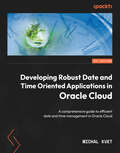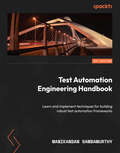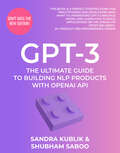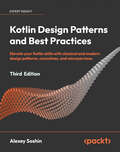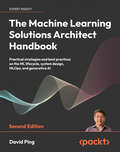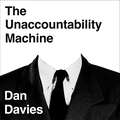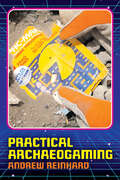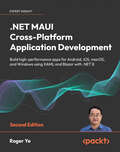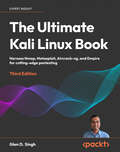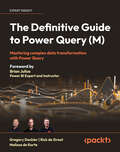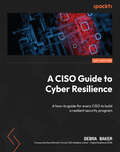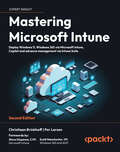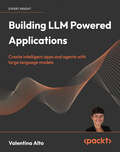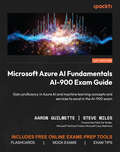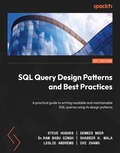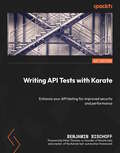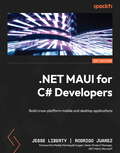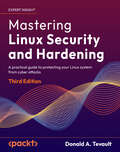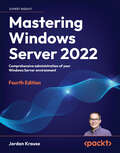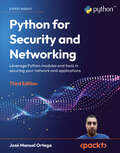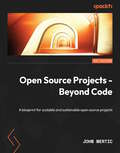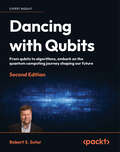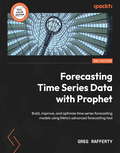- Table View
- List View
Developing Robust Date and Time Oriented Applications in Oracle Cloud: A comprehensive guide to efficient date and time management in Oracle Cloud
by Michal KvetCreate robust temporal solutions in Oracle Cloud and spread the solution worldwide by leveraging its regional properties and time zone synchronizationPurchase of the print or Kindle book includes a free PDF eBookKey FeaturesMigrate existing on-premises applications to the Oracle Cloud environment using data migration techniquesHandle date and time values efficiently using Oracle database's available data types and duration modeling principlesApply temporal database models in real-world systems to ensure robustness, security, and performanceBook DescriptionProper date and time management is critical for the development and reliability of Oracle Databases and cloud environments, which are among the most rapidly expanding technologies today. This knowledge can be applied to cloud technology, on premises, application development, and integration to emphasize regional settings, UTC coordination, or different time zones. This practical book focuses on code snippets and discusses the existing functionalities and limitations, along with covering data migration to the cloud by emphasizing the importance of proper date and time management. This book helps you understand the historical background and evolution of ANSI standards. You'll get to grips with data types, constructor principles, and existing functionalities, and focus on the limitations of regional parameters and time zones, which help in expanding business to other parts of the world. You'll also explore SQL injection threats, temporal database architecture, using Flashback Technology to reconstruct valid database images from the past, time zone management, and UTC synchronization across regions. By the end of this book, you'll be able to create and manage temporal systems, prevent SQL injection attacks, use existing functionalities and define your own robust solutions for date management, and apply time zone and region rules.What you will learnExplore the fundamentals and terms related to Oracle Cloud Infrastructure (OCI) and data migrationFollow core principles and date and time element management supervised by ANSI standardizationDiscover the limitations of existing functionalities and conversion methodsBuild robust and secure temporal solutions that are resistant to SQL injection threatsUnderstand time zone management and regional settings by focusing on regional and national conventions and approachesUse Flashback Technology to create temporal models in terms of historical and current statesWho this book is forThis book is for IT specialists, students, system developers, database administrators, and cloud integrators. With a hands-on approach, this book will help you to gain a comprehensive view of the issue of time processing and enable you to develop complex, robust applications that are usable and portable in any region.
Test Automation Engineering Handbook: Learn and implement techniques for building robust test automation frameworks
by Manikandan SambamurthyUnderstand test automation and implement it in Web, Mobile, and APIs effectivelyKey FeaturesLearn how to automate your tests with the help of practical examplesUnderstand how to bridge the gap between testing and test automationExplore test automation strategies for different platformsBook DescriptionThis book helps you build a better understanding of test automation and aids in bridging the gap between testing and test automation.The book has been divided into three sections with the first section focusing on preparing you for testing and test automation fundamentals. By the end of this section, you'll have an understanding of some common automation terms, definitions, and roles. The second section covers the practical implementation of test automation for mobile, web, API and performance. The third section will help you understand how test automation works with CI/CD, and explore the common issues and pitfalls when executing test automation.By the end of this book, you'll have a better understanding of automation, addressing the common pain points and best practices around test automation.What you will learnGain a solid understanding of test automationUnderstand how automation fits into a test strategyExplore essential design patterns for test automationDesign and implement highly reliable automated testsUnderstand issues and pitfalls when executing test automationDiscover the commonly used test automation tools/frameworksWho this book is forThis book is for manual testers who want to enter the field of test automation and developers who want to learn more about test automation.
GPT-3: The Ultimate Guide To Building NLP Products With OpenAI API
by Sandra Kublik Shubham SabooGPT-3: The Ultimate Guide To Building NLP Products With OpenAI API is a comprehensive book on the Generative Pre-trained Transformer 3 AI language model, covering its significance, capabilities, and application in creating innovative NLP Products.Key FeaturesExploration of GPT-3: The book explores GPT-3, a powerful language model, and its capabilitiesBusiness applications: The book provides practical knowledge on using GPT-3 to create new business productsExamination of AI trends: The book examines the impact of GPT-3 on emerging creator economy and trends like no-code & AGIBook DescriptionGPT-3 has made creating AI apps simpler than ever. This book provides a comprehensive guide on how to utilize the OpenAI API with ease. It explores imaginative methods of utilizing this tool for your specific needs and showcases successful businesses that have been established through its use.The book is divided into two sections, with the first focusing on the fundamentals of the OpenAI API. The second part examines the dynamic and thriving environment that has arisen around GPT-3.Chapter 1 sets the stage with background information and defining key terms. Chapter 2 goes in-depth into the API, breaking it down into its essential components, explaining their functions and offering best practices. Chapter 3, you will build your first app with GPT-3.Chapter 4 features interviews with the founders of successful GPT-3-based products, who share challenges and insights gained. Chapter 5 examines the perspective of enterprises on GPT-3 and its potential for adoption. The problematic consequences of widespread GPT-3 adoption, such as misapplication and bias, are addressed along with efforts to resolve these issues in Chapter 6. Finally, Chapter 7 delves into the future by exploring the most exciting trends and possibilities as GPT-3 becomes increasingly integrated into the commercial ecosystem.What you will learnLearn the essential components of the OpenAI API along with the best practicesBuild and deploy your first GPT-3 powered applicationLearn from the journeys of industry leaders, startup founders who have built and deployed GPT-3 based products at scaleLook at how enterprises view GPT-3 and its potential for adoption for scalable solutionsNavigating the Consequences of GPT-3 adoption and efforts to resolve themExplore the exciting trends and possibilities of combining models with GPT-3 with No codeWho this book is forThis book caters to individuals from diverse backgrounds, not just technical experts. It should be useful to you if you are:A data expert seeking to improve your AI expertiseAn entrepreneur looking to revolutionize the AI industryA business leader seeking to enhance your AI knowledge and apply it to informed decision makingA content creator in the language domain looking to utilize GPT-3's language abilities for creative and imaginative projectsAnyone with an AI idea that was previously deemed technically unfeasible or too costly to execute
Kotlin Design Patterns and Best Practices: Elevate your Kotlin skills with classical and modern design patterns, coroutines, and microservices
by Alexey SoshinDive deep into Kotlin design patterns, explore idiomatic functional programming, and master microservices with frameworks like Arrow, Ktor, and Vert.x.Key FeaturesStart from basic Kotlin syntax and go all the way to advanced topics like Coroutines and structural concurrencyLearn how to select and implement the right design pattern for your next Kotlin projectGet to grips with concurrent and reactive microservices with Ktor and Vert.xBook DescriptionFor developers who are working with design patterns in Kotlin, this practical guide offers an opportunity to put their knowledge into practice. The book covers classical and modern design patterns, and provides a hands-on approach to implementation, along with associated methodologies. The third edition stays current with Kotlin updates, spanning from version 1.6 onwards, and offers in-depth insights into topics like structured concurrency and context receivers. The book starts by introducing essential Kotlin syntax and the significance of design patterns, covering classic Creational, Structural, and Behavioral patterns. It then progresses to explore functional programming, Reactive, and Concurrent patterns, including detailed discussions on coroutines and structured concurrency. As you navigate through these advanced concepts, you'll enhance your Kotlin coding skills. The book also delves into the latest architectural trends, focusing on microservices design patterns and aiding your decision-making process when choosing between architectures. By the end of the book, you will have a solid grasp of these advanced concepts and be able to apply them in your own projects.What you will learnUtilize functional programming and coroutines with the Arrow frameworkUse classical design patterns in the Kotlin programming languageScale your applications with reactive and concurrent design patternsDiscover best practices in Kotlin and explore its new featuresApply the key principles of functional programming to KotlinFind out how to write idiomatic Kotlin code and learn which patterns to avoidHarness the power of Kotlin to design concurrent and reliable systems with easeCreate an effective microservice with Kotlin and the Ktor frameworkWho this book is forThis book is for developers who want to apply design patterns they've learned from other languages in Kotlin and build reliable, scalable, and maintainable applications. You'll need a good grasp on at least one programming language before you get started with this book. Familiarity with classical design patterns from your language of choice would be helpful, but you'll still be able to follow along if you code in other languages
The Machine Learning Solutions Architect Handbook: Practical strategies and best practices on the ML lifecycle, system design, MLOps, and generative AI
by David PingDesign, build, and secure scalable machine learning (ML) systems to solve real-world business problems with Python and AWS Purchase of the print or Kindle book includes a free PDF eBookKey FeaturesGo in-depth into the ML lifecycle, from ideation and data management to deployment and scalingApply risk management techniques in the ML lifecycle and design architectural patterns for various ML platforms and solutionsUnderstand the generative AI lifecycle, its core technologies, and implementation risksBook DescriptionDavid Ping, Head of GenAI and ML Solution Architecture for global industries at AWS, provides expert insights and practical examples to help you become a proficient ML solutions architect, linking technical architecture to business-related skills. You'll learn about ML algorithms, cloud infrastructure, system design, MLOps , and how to apply ML to solve real-world business problems. David explains the generative AI project lifecycle and examines Retrieval Augmented Generation (RAG), an effective architecture pattern for generative AI applications. You’ll also learn about open-source technologies, such as Kubernetes/Kubeflow, for building a data science environment and ML pipelines before building an enterprise ML architecture using AWS. As well as ML risk management and the different stages of AI/ML adoption, the biggest new addition to the handbook is the deep exploration of generative AI. By the end of this book , you’ll have gained a comprehensive understanding of AI/ML across all key aspects, including business use cases, data science, real-world solution architecture, risk management, and governance. You’ll possess the skills to design and construct ML solutions that effectively cater to common use cases and follow established ML architecture patterns, enabling you to excel as a true professional in the field.What you will learnApply ML methodologies to solve business problems across industriesDesign a practical enterprise ML platform architectureGain an understanding of AI risk management frameworks and techniquesBuild an end-to-end data management architecture using AWSTrain large-scale ML models and optimize model inference latencyCreate a business application using artificial intelligence services and custom modelsDive into generative AI with use cases, architecture patterns, and RAGWho this book is forThis book is for solutions architects working on ML projects, ML engineers transitioning to ML solution architect roles, and MLOps engineers. Additionally, data scientists and analysts who want to enhance their practical knowledge of ML systems engineering, as well as AI/ML product managers and risk officers who want to gain an understanding of ML solutions and AI risk management, will also find this book useful. A basic knowledge of Python, AWS, linear algebra, probability, and cloud infrastructure is required before you get started with this handbook.
The Unaccountability Machine: Why Big Systems Make Terrible Decisions - and How The World Lost its Mind
by Dan Davies'A corporation, or a government department isn't a conscious being, but it is an artificial intelligence. It has the capability to take decisions which are completely distinct from the intentions of any of the people who compose it. And under stressful conditions, it can go stark raving mad.'When we avoid taking a decision, what happens to it? In The Unaccountability Machine, Dan Davies examines why markets, institutions and even governments systematically generate outcomes that everyone involved claims not to want. He casts new light on the writing of Stafford Beer, a legendary economist who argued in the 1950s that we should regard organisations as artificial intelligences, capable of taking decisions that are distinct from the intentions of their members. Management cybernetics was Beer's science of applying self-regulation in organisational settings, but it was largely ignored - with the result being the political and economic crises that that we see today. With his signature blend of cynicism and journalistic rigour, Davies looks at what's gone wrong, and what might have been, hadthe world listened to Stafford Beer when it had the chance.
Practical Archaeogaming
by Andrew ReinhardAs a sequel to Archaeogaming: an Introduction to Archaeology in and of Video Games, the author focuses on the practical and applied side of the discipline, collecting recent digital fieldwork together in one place for the first time to share new methods in treating interactive digital built environments as sites for archaeological investigation. Fully executed examples of practical and applied archaeogaming include the necessity of a rapid archaeology of digital built environments, the creation of a Harris matrix for software stratigraphy, the ethnographic work behind a human civilization trapped in an unstable digital landscape, how to conduct photogrammetry and GIS mapping in procedurally generated space, and how to transform digital artifacts into printed three-dimensional objects. Additionally, the results of the 2014 Atari excavation in Alamogordo, New Mexico are summarized for the first time.
.NET MAUI Cross-Platform Application Development: Build high-performance apps for Android, iOS, macOS, and Windows using XAML and Blazor with .NET 8
by Roger YeBuild apps using .NET MAUI and Blazor with this comprehensive, revised guide for .NET 8. Purchase of the print or Kindle book includes a free eBook in PDF format.Key FeaturesHandle data effectively with expanded coverage on the MVVM model and data bindingIntegrate platform-specific code using plugins and custom controlsMigrate from Xamarin.Forms to .NET MAUI for the latest hybrid app development capabilitiesBook DescriptionAn evolution of Xamarin.Forms, .NET MAUI is a cross-platform framework for creating native mobile and desktop apps with C# and XAML. Using .NET MAUI, you can develop apps that’ll run on Android, iOS, macOS, and Windows from a single shared codebase. In this revised edition of .NET MAUI Cross-Platform Application Development you will be introduced to .NET 8 and get up to speed with app development in no time. The book begins by showing you how to develop a cross-platform application using .NET MAUI, including guidance for migrating from Xamarin.Forms. You’ll gain all the knowledge needed to create a cross-platform application for Android, iOS, macOS, and Windows following an example project step by step. As you advance, you’ll integrate the latest frontend technology into your app using Blazor components, including the new Blazor Bindings feature. After this, you’ll learn how to test and deploy your apps. With new coverage on creating mock .NET MAUI components, you can develop unit tests for your application. You will additionally learn how to perform Razor component testing using bUnit. By the end of this book, you’ll have learned how to develop your own cross-platform applications using .NET MAUI.What you will learnDevelop high-performance apps with logical user interfacesImprove the maintainability of apps using the MVVM design patternUnderstand the progression from Xamarin.Forms and how to migrate to .NETDelve into templated components and Razor class libraries for crafting Blazor UI elementsPublish your creations to major app stores with guidance on preparation and processesExtend your testing repertoire with bUnit for Razor components for reliable unit testingWho this book is forThis book is for mobile developers interested in cross-platform application development with working experience of the .NET Core framework, as well as junior engineers who’ve just begun their career in mobile app development. Native app developers (desktop) or Xamarin developers who want to migrate to .NET MAUI will also benefit from this book. Basic knowledge of modern object-oriented programming languages, such as C#, Java or Kotlin, is assumed.
The Ultimate Kali Linux Book: Harness Nmap, Metasploit, Aircrack-ng, and Empire for cutting-edge pentesting
by Glen D. SinghExcel in penetration testing by delving into the latest ethical hacking tools and techniques from scratch Purchase of the print or Kindle book includes a free eBook in PDF format.Key FeaturesLearn to think like an adversary to strengthen your cyber defencesExecute sophisticated real-life penetration tests, uncovering vulnerabilities in enterprise networks that go beyond the surface levelSecurely manipulate environments using Kali Linux, ensuring you're fully equipped to safeguard your systems against real-world threatsBook DescriptionEmbark on an exciting journey into the world of Kali Linux – the central hub for advanced penetration testing. Honing your pentesting skills and exploiting vulnerabilities or conducting advanced penetration tests on wired and wireless enterprise networks, Kali Linux empowers cybersecurity professionals. In its latest third edition, this book goes further to guide you on how to setup your labs and explains breaches using enterprise networks. This book is designed for newcomers and those curious about penetration testing, this guide is your fast track to learning pentesting with Kali Linux 2024.x. Think of this book as your stepping stone into real-world situations that guides you through lab setups and core penetration testing concepts. As you progress in the book you’ll explore the toolkit of vulnerability assessment tools in Kali Linux, where gathering information takes the spotlight. You'll learn how to find target systems, uncover device security issues, exploit network weaknesses, control operations, and even test web applications. The journey ends with understanding complex web application testing techniques, along with industry best practices. As you finish this captivating exploration of the Kali Linux book, you'll be ready to tackle advanced enterprise network testing – with newfound skills and confidence.What you will learnEstablish a firm foundation in ethical hackingInstall and configure Kali Linux 2024.1Build a penetration testing lab environment and perform vulnerability assessmentsUnderstand the various approaches a penetration tester can undertake for an assessmentGathering information from Open Source Intelligence (OSINT) data sourcesUse Nmap to discover security weakness on a target system on a networkImplement advanced wireless pentesting techniquesBecome well-versed with exploiting vulnerable web applicationsWho this book is forThis pentesting book is for students, trainers, cybersecurity professionals, cyber enthusiasts, network security professionals, ethical hackers, penetration testers, and security engineers. If you do not have any prior knowledge and are looking to become an expert in penetration testing using the Kali Linux, then this book is for you.
The Definitive Guide to Power Query (M): Mastering complex data transformation with Power Query
by Gregory Deckler Rick de Groot Melissa de KorteLearn how to use the Power Query M formula language and its functions effectively for better data modeling and impactful business intelligence reports. Purchase of the print or Kindle book includes a free PDF eBookKey FeaturesGet comprehensive coverage of fundamental and advanced Power Query conceptsGain hands-on experience with practical examples based on real-world problemsDelve into the intricacies of Power Query M language for enhanced data manipulationBook DescriptionData transformation is a critical step in building data models and business intelligence reports. Power Query is an invaluable tool for anyone who wants to master data transformation, and this book will equip you with the knowledge and skills to make the most of it. The Definitive Guide to Power Query (M) will help you build a solid foundation in the Power Query M language. As you progress through the chapters, you'll learn how to use that knowledge to implement advanced concepts and data transformations. This will set the stage for an uncompromisingly thorough exploration of the Power Query M Language. You'll also get to grips with optimizing performance, handling errors, and implementing efficient data processing techniques. As this is a hands-on guide, the practical examples in the chapters will help you gain the skills to apply Power Query to real-world problems and improve your data analysis capabilities. By the end of this book, you will be able to leverage all of Power Query's remarkable capabilities for data transformation.What you will learnGain a strong understanding of Power Query fundamentalsMaster various functions within Power Query to perform complex data operationsAcquire knowledge about values, types, and control structures in Power QueryDevelop proficiency in error handling techniquesLearn performance optimization strategies for Power QueryApply what you’ve learned to real-world scenarios, including common troublesome patternsWho this book is forThis book is for business analysts, business intelligence professionals, and power business users working with data who want to add Power Query mastery to their resume. This book will be beneficial for anyone who wants to automate their process of data cleaning and save huge amount of time. Having some basic experience in Power Query is recommended.
Beginning C++ Game Programming: Learn C++ from scratch by building fun games
by John HortonGet to grips with programming and game development techniques using C++ libraries and Visual Studio 2022 with this updated edition of the bestselling series.Key FeaturesCreate fun games in C++, with this up-to-date guide covering the latest features of C++20 and VS2022Build clones of popular games such as a Timberman clone, a Pong game, a Zombie Survival Shooter, and a platform endless runner gameDiscover tips to expand your finished games by thinking critically, technically, and creativelyBook DescriptionAlways dreamed of creating your own games? With the third edition of Beginning C++ Game Programming, you can turn that dream into reality! This beginner-friendly guide is updated and improved to include the latest features of VS 2022, SFML, and modern C++20 programming techniques. You'll get a fun introduction to game programming by building four fully playable games of increasing complexity. You'll build clones of popular games such as Timberman, Pong, a Zombie survival shooter, and an endless runner. The book starts by covering the basics of programming. You'll study key C++ topics, such as object-oriented programming (OOP) and C++ pointers and get acquainted with the Standard Template Library (STL). The book helps you learn about collision detection techniques and game physics by building a Pong game. As you build games, you'll also learn exciting game programming concepts such as vertex arrays, directional sound (spatialization), OpenGL programmable shaders, spawning objects, and much more. You’ll dive deep into game mechanics and implement input handling, levelling up a character, and simple enemy AI. Finally, you'll explore game design patterns to enhance your C++ game programming skills. By the end of the book, you'll have gained the knowledge you need to build your own games with exciting features from scratch.What you will learnSet up your game project in VS 2022 and explore C++ libraries such as SFMLBuild games in C++ from the ground up, including graphics, physics, and input handlingImplement core game concepts such as game animation, game physics, collision detection, scorekeeping, and game soundImplement automatically spawning objects and AI to create rich and engaging experiencesLearn advanced game development concepts, such as OpenGL shaders, texture atlases, and parallax backgroundsScale and reuse your game code with modern game programming design patternsWho this book is forThis book is perfect for you if you have no C++ programming knowledge, you need a beginner-level refresher course, or you want to learn how to build games or just use games as an engaging way to learn C++. Whether you aspire to publish a game (perhaps on Steam) or just want to impress friends with your creations, you'll find this book useful
Data Quality in the Age of AI: Building a foundation for AI strategy and data culture
by Andrew JonesUnlock the power of data with expert insights to enhance data quality, maximizing the potential of AI, and establishing a data-centric cultureKey FeaturesGain a profound understanding of the interplay between data quality and AIExplore strategies to improve data quality with practical implementation and real-world resultsAcquire the skills to measure and evaluate data quality, empowering data-driven decisionsPurchase of the Kindle book includes a free PDF eBookBook DescriptionAs organizations worldwide seek to revamp their data strategies to leverage AI advancements and benefit from newfound capabilities, data quality emerges as the cornerstone for success. Without high-quality data, even the most advanced AI models falter. Enter Data Quality in the Age of AI, a detailed report that illuminates the crucial role of data quality in shaping effective data strategies. Packed with actionable insights, this report highlights the critical role of data quality in your overall data strategy. It equips teams and organizations with the knowledge and tools to thrive in the evolving AI landscape, serving as a roadmap for harnessing the power of data quality, enabling them to unlock their data's full potential, leading to improved performance, reduced costs, increased revenue, and informed strategic decisions.What you will learnDiscover actionable steps to establish data quality as the foundation of your data cultureEnhance data quality directly at its source with effective strategies and best practicesElevate data quality standards and enhance data literacy within your organizationIdentify and measure data quality within the datasetAdopt a product mindset to address data quality challengesExplore emerging architectural patterns like data mesh and data contractsAssign roles, responsibilities, and incentives for data generatorsGain insights from real-world case studiesWho this book is forThis report is for data leaders and decision-makers, including CTOs, CIOs, CISOs, CPOs, and CEOs responsible for shaping their organization's data strategy to maximize data value, especially those interested in harnessing recent AI advancements.
A CISO Guide to Cyber Resilience: A how-to guide for every CISO to build a resilient security program
by Debra BakerExplore expert strategies to master cyber resilience as a CISO, ensuring your organization's security program stands strong against evolving threatsKey FeaturesUnlock expert insights into building robust cybersecurity programsBenefit from guidance tailored to CISOs and establish resilient security and compliance programsStay ahead with the latest advancements in cyber defense and risk management including AI integrationPurchase of the print or Kindle book includes a free PDF eBookBook DescriptionThis book, written by the CEO of TrustedCISO with 30+ years of experience, guides CISOs in fortifying organizational defenses and safeguarding sensitive data. Analyze a ransomware attack on a fictional company, BigCo, and learn fundamental security policies and controls. With its help, you’ll gain actionable skills and insights suitable for various expertise levels, from basic to intermediate. You’ll also explore advanced concepts such as zero-trust, managed detection and response, security baselines, data and asset classification, and the integration of AI and cybersecurity. By the end, you'll be equipped to build, manage, and improve a resilient cybersecurity program, ensuring your organization remains protected against evolving threats.What you will learnDefend against cybersecurity attacks and expedite the recovery processProtect your network from ransomware and phishingUnderstand products required to lower cyber riskEstablish and maintain vital offline backups for ransomware recoveryUnderstand the importance of regular patching and vulnerability prioritizationSet up security awareness trainingCreate and integrate security policies into organizational processesWho this book is forThis book is for new CISOs, directors of cybersecurity, directors of information security, aspiring CISOs, and individuals who want to learn how to build a resilient cybersecurity program. A basic understanding of cybersecurity concepts is required.
Mastering Microsoft Intune: Deploy Windows 11, Windows 365 via Microsoft Intune, Copilot and advance management via Intune Suite
by Christiaan Brinkhoff Per LarsenGet ready to master Microsoft Intune and revolutionize your endpoint management strategy with this comprehensive guide and and provide next-level security with the Intune Suite. Includes forewords from Scott Manchester, Vice President, Windows 365 + AVD and Steve Dispensa Corporate Vice President, Microsoft Intune.Key FeaturesThis new edition covers the latest updates of Microsoft Intune, Windows 365, Intune Suite, Windows Autopatch, Microsoft Defender and Universal PrintGet detailed guidance on device enrolment, app deployment, management, data security, and policy configurationSecure data on personal devices with app policies, encryption, and moreBook DescriptionThe slow adoption of Modern Work solutions, which are designed to streamline the management of your environment, can often be attributed to a lack of understanding and familiarity with the product. This book will provide you with all the information you need to successfully transition to Microsoft Intune Mastering Microsoft Intune explains various concepts in detail to give you the clarity to plan how to use Microsoft Intune and eliminate potential migration challenges beforehand. You'll get to master Cloud Computing services such as Windows 365 Cloud PC, Intune Suite, Windows Autopatch, Windows Autopilot, profile management, monitoring and analytics, Universal Print, and much more. The book will take you through the latest features and new Microsoft cloud services to help you to get to grips with the fundamentals of Intune and understand which services you can manage. Whether you are talking about physical or cloud endpoints it's all covered. By the end of the book, you'll be able to set up Intune and use it to run Windows, and Windows 365 efficiently via Intune with all the latest features included. What you will learnSimplify the deployment of Windows in the cloud with Windows 365 Cloud PCDeliver next-generation security features with Intune suiteSimplify Windows Updates with Windows AutopatchConfigure advanced policy management within IntuneDiscover modern profile management and migration options for physical and cloud PCsHarden security with baseline settings and other security best practicesFind troubleshooting tips and tricks for Intune, Windows 365 Cloud PC, and moreDiscover deployment best practices for physical and cloud-managed endpointsWho this book is forIf you are an IT professional, enterprise mobility administrator, architect, or consultant looking to learn about managing Windows on both physical and cloud endpoints using Microsoft Intune, then this book is for you.
Building LLM Powered Applications: Create intelligent apps and agents with large language models
by Valentina AltoGet hands-on with GPT 3.5, GPT 4, LangChain, Llama 2, Falcon LLM and more, to build LLM-powered sophisticated AI applicationsKey FeaturesEmbed LLMs into real-world applicationsUse LangChain to orchestrate LLMs and their components within applicationsGrasp basic and advanced techniques of prompt engineeringBook DescriptionBuilding LLM Powered Applications delves into the fundamental concepts, cutting-edge technologies, and practical applications that LLMs offer, ultimately paving the way for the emergence of large foundation models (LFMs) that extend the boundaries of AI capabilities. The book begins with an in-depth introduction to LLMs. We then explore various mainstream architectural frameworks, including both proprietary models (GPT 3.5/4) and open-source models (Falcon LLM), and analyze their unique strengths and differences. Moving ahead, with a focus on the Python-based, lightweight framework called LangChain, we guide you through the process of creating intelligent agents capable of retrieving information from unstructured data and engaging with structured data using LLMs and powerful toolkits. Furthermore, the book ventures into the realm of LFMs, which transcend language modeling to encompass various AI tasks and modalities, such as vision and audio. Whether you are a seasoned AI expert or a newcomer to the field, this book is your roadmap to unlock the full potential of LLMs and forge a new era of intelligent machines.What you will learnExplore the core components of LLM architecture, including encoder-decoder blocks and embeddingsUnderstand the unique features of LLMs like GPT-3.5/4, Llama 2, and Falcon LLMUse AI orchestrators like LangChain, with Streamlit for the frontendGet familiar with LLM components such as memory, prompts, and toolsLearn how to use non-parametric knowledge and vector databasesUnderstand the implications of LFMs for AI research and industry applicationsCustomize your LLMs with fine tuningLearn about the ethical implications of LLM-powered applicationsWho this book is for Software engineers and data scientists who want hands-on guidance for applying LLMs to build applications. The book will also appeal to technical leaders, students, and researchers interested in applied LLM topics. We don’t assume previous experience with LLM specifically. But readers should have core ML/software engineering fundamentals to understand and apply the content.
Microsoft Azure AI Fundamentals AI-900 Exam Guide: Gain proficiency in Azure AI and machine learning concepts and services to excel in the AI-900 exam
by Steve Miles Aaron GuilmetteGet ready to pass the certification exam on your first attempt by gaining actionable insights into AI concepts, ML techniques, and Azure AI services covered in the latest AI-900 exam syllabus from two industry experts Key FeaturesDiscover Azure AI services, including computer vision, Auto ML, NLP, and OpenAIExplore AI use cases, such as image identification, chatbots, and moreWork through 145 practice questions under chapter-end self-assessments and mock examsPurchase of this book unlocks access to web-based exam prep resources, including mock exams, flashcards, and exam tipsBook DescriptionThe AI-900 exam helps you take your first step into an AI-shaped future. Regardless of your technical background, this book will help you test your understanding of the key AI-related topics and tools used to develop AI solutions in Azure cloud. This exam guide focuses on AI workloads, including natural language processing (NLP) and large language models (LLMs). You’ll explore Microsoft’s responsible AI principles like safety and accountability. Then, you’ll cover the basics of machine learning (ML), including classification and deep learning, and learn how to use training and validation datasets with Azure ML. Using Azure AI Vision, face detection, and Video Indexer services, you’ll get up to speed with computer vision-related topics like image classification, object detection, and facial detection. Later chapters cover NLP features such as key phrase extraction, sentiment analysis, and speech processing using Azure AI Language, speech, and translator services. The book also guides you through identifying GenAI models and leveraging Azure OpenAI Service for content generation. At the end of each chapter, you’ll find chapter review questions with answers, provided as an online resource. By the end of this exam guide, you’ll be able to work with AI solutions in Azure and pass the AI-900 exam using the online exam prep resources.What you will learnDiscover various types of artificial intelligence (AI)workloads and services in AzureCover Microsoft's guiding principles for responsible AI development and useUnderstand the fundamental principles of how AI and machine learning workExplore how AI models can recognize content in images and documentsGain insights into the features and use cases for natural language processingExplore the capabilities of generative AI servicesWho this book is forWhether you're a cloud engineer, software developer, an aspiring data scientist, or simply interested in learning AI/ML concepts and capabilities on Azure, this book is for you. The book also serves as a foundation for those looking to attempt more advanced AI and data science-related certification exams (e.g. Microsoft Certified: Azure AI Engineer Associate). Although no experience in data science and software engineering is required, basic knowledge of cloud concepts and client-server applications is assumed.
SQL Query Design Patterns and Best Practices: A practical guide to writing readable and maintainable SQL queries using its design patterns
by Steve Hughes Dennis Neer Dr. Ram Singh Shabbir H. Mala Leslie AndrewsEnhance your SQL query writing skills to provide greater business value using advanced techniques such as common table expressions, window functions, and JSONPurchase of the print or Kindle book includes a free PDF eBookKey FeaturesExamine query design and performance using query plans and indexesSolve business problems using advanced techniques such as common table expressions and window functionsUse SQL in modern data platform solutions with JSON and Jupyter notebooksBook DescriptionSQL has been the de facto standard when interacting with databases for decades and shows no signs of going away. Through the years, report developers or data wranglers have had to learn SQL on the fly to meet the business needs, so if you are someone who needs to write queries, SQL Query Design and Pattern Best Practices is for you.This book will guide you through making efficient SQL queries by reducing set sizes for effective results. You'll learn how to format your results to make them easier to consume at their destination. From there, the book will take you through solving complex business problems using more advanced techniques, such as common table expressions and window functions, and advance to uncovering issues resulting from security in the underlying dataset. Armed with this knowledge, you'll have a foundation for building queries and be ready to shift focus to using tools, such as query plans and indexes, to optimize those queries. The book will go over the modern data estate, which includes data lakes and JSON data, and wrap up with a brief on how to use Jupyter notebooks in your SQL journey.By the end of this SQL book, you'll be able to make efficient SQL queries that will improve your report writing and the overall SQL experience.What you will learnBuild efficient queries by reducing the data being returnedManipulate your data and format it for easier consumptionForm common table expressions and window functions to solve complex business issuesUnderstand the impact of SQL security on your resultsUnderstand and use query plans to optimize your queriesUnderstand the impact of indexes on your query performance and designWork with data lake data and JSON in SQL queriesOrganize your queries using Jupyter notebooksWho this book is forThis book is for SQL developers, data analysts, report writers, data scientists, and other data gatherers looking to expand their skills for complex querying as well as for building more efficient and performant queries.For those new to SQL, this book can help you accelerate your learning and keep you from making common mistakes.
Writing API Tests with Karate: Enhance your API testing for improved security and performance
by Benjamin Bischoff Peter ThomasUnlock the full potential of Karate with this comprehensive guide to effortlessly setup, write, run, optimize, and report test resultsPurchase of the print or Kindle book includes a free PDF eBookKey FeaturesExplore the capabilities of the Karate framework for effective software testingLearn how to integrate Karate tests into projects and CI/CD pipelinesExplore lesser-known Karate modules such as Karate UI and Karate GatlingBook DescriptionSoftware in recent years is moving away from centralized systems and monoliths to smaller, scalable components that communicate with each other through APIs. Testing these communication interfaces is becoming increasingly important to ensure the security, performance, and extensibility of the software. A powerful tool to achieve safe and robust applications is Karate, an easy-to-use, and powerful software testing framework. In this book, you'll work with different modules of karate to get tailored solutions for modern test challenges. You'll be exploring interface testing, UI testing as well as performance testing. By the end of this book, you'll be able to use the Karate framework in your software development lifecycle to make your APIs and applications robust and trustworthy.What you will learnUnderstand the basic concepts of Karate and its functionalityIntegrate and use it effectively to solve your testing needsExtend Karate and customize its functionality for your use casesExplore different testing methods and their use casesRun your tests to check the software development lifecycleGet to know more about Karate's UI and performance test approachesWho this book is forThis book is for QA engineers and developers who are familiar with APIs and want to make them safer and more secure by applying automated tests with the help of a lightweight and modern framework - Karate.
.NET MAUI for C# Developers: Build cross-platform mobile and desktop applications
by Jesse Liberty Rodrigo Juarez Maddy Montaquila (Leger)A practical guide to mastering C# and .NET MAUI to build native cross-platform apps with a single codebasePurchase of the print or Kindle book includes a free PDF eBookKey FeaturesExtend your skills to build cross-platform native apps for iOS, Android, Windows, and MacLearn by working on a real-world projectGo beyond MAUI and integrate with the .NET ecosystemBook DescriptionWhile UI plays a pivotal role in retaining users in a highly competitive landscape, maintaining the same UI can be tricky if you use different languages for different platforms, leading to mismatches and un-synced pages. In this book, you'll see how .NET MAUI allows you to create a real-world application that will run natively on different platforms. By building on your C# experience, you'll further learn to create beautiful and engaging UI using XAML, architect a solid app, and discover best practices for this Microsoft platform. The book starts with the fundamentals and quickly moves on to intermediate and advanced topics on laying out your pages, navigating between them, and adding controls to gather and display data. You'll explore the key architectural pattern of Model-View-ViewModel: and ways to leverage it. You'll also use xUnit and NSubstitute to create robust and reliable code.By the end of this book, you'll be well-equipped to leverage .NET MAUI and create an API for your app to interact with a web frontend to the backend data using C#.What you will learnExplore the fundamentals of creating .NET MAUI apps with Visual StudioUnderstand XAML as the key tool for building your user interfaceObtain and display data using layout and controlsDiscover the MVVM pattern to create robust appsAcquire the skills for storing and retrieving persistent dataUse unit testing to ensure your app is solid and reliableWho this book is forLearning .NET MAUI is targeted squarely at C# programmers, whether or not they have experience with cross-platform or mobile applications, who wish to learn Microsoft's premier platform for building iOS, Android, Windows and Mac apps using a single C#-based solution.
Mastering Linux Security and Hardening: A practical guide to protecting your Linux system from cyber attacks, 3rd Edition
by Donald A. TevaultGain a firm practical understanding of how to secure your Linux system from intruders, malware attacks, and other cyber threatsPurchase of the print or Kindle book includes a free eBook in PDF format.Key FeaturesDiscover security techniques to prevent malware from infecting a Linux system, and detect itPrevent unauthorized people from breaking into a Linux systemProtect important and sensitive data from being revealed to unauthorized personsBook DescriptionThe third edition of Mastering Linux Security and Hardening is an updated, comprehensive introduction to implementing the latest Linux security measures, using the latest versions of Ubuntu and AlmaLinux.In this new edition, you will learn how to set up a practice lab, create user accounts with appropriate privilege levels, protect sensitive data with permissions settings and encryption, and configure a firewall with the newest firewall technologies. You'll also explore how to use sudo to set up administrative accounts with only the privileges required to do a specific job, and you'll get a peek at the new sudo features that have been added over the past couple of years. You'll also see updated information on how to set up a local certificate authority for both Ubuntu and AlmaLinux, as well as how to automate system auditing. Other important skills that you'll learn include how to automatically harden systems with OpenSCAP, audit systems with auditd, harden the Linux kernel configuration, protect your systems from malware, and perform vulnerability scans of your systems. As a bonus, you'll see how to use Security Onion to set up an Intrusion Detection System.By the end of this new edition, you will confidently be able to set up a Linux server that will be secure and harder for malicious actors to compromise.What you will learnPrevent malicious actors from compromising a production Linux systemLeverage additional features and capabilities of Linux in this new versionUse locked-down home directories and strong passwords to create user accountsPrevent unauthorized people from breaking into a Linux systemConfigure file and directory permissions to protect sensitive dataHarden the Secure Shell service in order to prevent break-ins and data lossApply security templates and set up auditingWho this book is forThis book is for Linux administrators, system administrators, and network engineers interested in securing moderate to complex Linux environments. Security consultants looking to enhance their Linux security skills will also find this book useful. Working experience with the Linux command line and package management is necessary to understand the concepts covered in this book.
Mastering Windows Server 2022: Comprehensive administration of your Windows Server environment, 4th Edition
by Jordan KrauseThe complete guide for system administrators to install, manage, secure, and squeeze return on investment from their Windows Server 2022 infrastructurePurchase of the print or Kindle book includes a free eBook in PDF format.Key FeaturesDesign and implement Microsoft Server 2022 in an enterprise environment and use Windows Server to create secure and efficient networksConcentrated learning on Windows core infrastructure technologiesDiscover how to harden and secure your Windows Server infrastructureBook DescriptionWritten by a 10-time Microsoft MVP award winner with over 20 years of IT experience, Mastering Windows Server 2022 is a hands-on guide to administer any Windows Server environment. Whether new to the server world or working to keep your existing skills sharp, this book aims to be referenced on a regular basis instead of gathering dust on your shelf.Updated with Server 2022 content, this book covers a wide variety of information pertaining to your role as a server administrator. We will expand upon versions and licensing models for this OS, and explore the 'single pane of glass' administration methodology by utilizing tools like Server Manager, PowerShell, and even Windows Admin Center. This book is primarily focused on Windows Server 2022 LTSC version, but follow along as we discuss the latest news for SAC server releases as this impacts Containers, Nano Server, and general OS release cadence.This book covers a range of remote access technologies, and even teaches management of PKI and certificates. You will be empowered to virtualize your datacenter with Hyper-V, and deploy your own Remote Desktop Services "farm". Learn about Server Core, built-in redundancy, and explore troubleshooting skills. All this on top of chapters about core infrastructure technologies such as Active Directory, DNS, DHCP, and Group Policy.What you will learnBuild a Windows Server from the ground up and implement your own PKIManage your servers with Server Manager, PowerShell, and Windows Admin CenterSecure your network and data with modern technologies in Windows Server 2022Understand containers and where Nano Server fits into the equationDiscover new ways to integrate your datacenter with Microsoft AzureVirtualize your datacenter with Hyper-VRound out your understanding of Active Directory, DNS, DHCP, and Group PolicyDeploy Remote Desktop Services in your environmentWho this book is forAnyone interested in Windows Server administration will benefit from this book. If you are proficient in Microsoft infrastructure technologies and have worked with prior versions of Windows Server, then there are some focused topics on the aspects that are brand new and only available in Server 2022. On the other hand, if you are currently in a desktop support role looking to advance, or fresh into the IT workforce, care was taken in the pages of this book to ensure that you will receive a rounded understanding of Windows Server core capabilities that translate into any environment
Python for Security and Networking: Leverage Python modules and tools in securing your network and applications, 3rd Edition
by Jose Manuel OrtegaGain a firm, practical understanding of securing your network and utilize Python's packages to detect vulnerabilities in your applicationKey FeaturesDiscover security techniques to protect your network and systems using PythonCreate scripts in Python to automate security and pentesting tasksAnalyze traffic in a network and extract information using PythonBook DescriptionPython's latest updates add numerous libraries that can be used to perform critical security-related missions, including detecting vulnerabilities in web applications, taking care of attacks, and helping to build secure and robust networks that are resilient to them. This fully updated third edition will show you how to make the most of them and improve your security posture.The first part of this book will walk you through Python scripts and libraries that you'll use throughout the book. Next, you'll dive deep into the core networking tasks where you will learn how to check a network's vulnerability using Python security scripting and understand how to check for vulnerabilities in your network – including tasks related to packet sniffing. You'll also learn how to achieve endpoint protection by leveraging Python packages along with writing forensics scripts.The next part of the book will show you a variety of modern techniques, libraries, and frameworks from the Python ecosystem that will help you extract data from servers and analyze the security in web applications. You'll take your first steps in extracting data from a domain using OSINT tools and using Python tools to perform forensics tasks.By the end of this book, you will be able to make the most of Python to test the security of your network and applications.What you will learnProgram your own tools in Python that can be used in a Network Security processAutomate tasks of analysis and extraction of information from serversDetect server vulnerabilities and analyze security in web applicationsAutomate security and pentesting tasks by creating scripts with PythonUtilize the ssh-audit tool to check the security in SSH serversExplore WriteHat as a pentesting reports tool written in PythonAutomate the process of detecting vulnerabilities in applications with tools like FuxploiderWho this book is forThis Python book is for network engineers, system administrators, and other security professionals looking to overcome common networking and security issues using Python. You will also find this book useful if you're an experienced programmer looking to explore Python's full range of capabilities. A basic understanding of general programming structures as well as familiarity with the Python programming language is a prerequisite.
Open Source Projects - Beyond Code: A blueprint for scalable and sustainable open source projects
by John MerticAccelerate your career and make an impact by launching and running a successful open source project. Purchase of the print or Kindle book includes a free PDF eBookKey FeaturesUnderstand the method and rationale for launching an open source projectExplore best practices and insights for running an open source projectLeverage open source projects to advance your careerBook DescriptionOpen source is ubiquitous in our society, with countless existing projects, and new ones emerging every day. It follows a "scratch-your-own-itch" model where contributors and maintainers drive the project forward. Through Open Source Projects - Beyond Code, you'll learn what it takes to develop a successful, scalable, and sustainable open source project. In this book, you'll explore the full life cycle of open source projects, from inception, through launch, to maturity, and then discover how to sunset an open source project responsibly. Along the way, you'll learn the concepts of licensing, governance, community building, ecosystem management, and growing maintainers and contributors, as well as understand how other open source projects have been successful or might have struggled in some areas. You can use this book as an end-to-end guide or reference material for the future. By the end of this book, you'll be able to accelerate your career in open source. Your newly acquired skills will help you stay ahead of the curve even with the ever-evolving nature of technology.What you will learnExplore what is open source and how you can use it to accelerate your careerStart an open source project while exploring its key considerationsGrow, support, and manage a vast community of developers and usersBuild and maintain a mature and sustainable projectEnable mass users and developers to downstream productization and outreachUse open source as a portfolio to build your careerUnderstand when to end a project and conduct it responsiblyWho this book is forThis book is for software developers, product managers, project managers, business leaders, or general enthusiasts looking to start an open source project or currently maintaining one.
Dancing with Qubits: From qubits to algorithms, embark on the quantum computing journey shaping our future
by Robert S. SutorUnlock the core math and understand the technical nuances of quantum computing in this detailed guide. Delve into the practicality of NISQ algorithms, and survey promising advancements in quantum machine learning.Key FeaturesDiscover how quantum computing works and delve into the math behind it with practical examplesLearn about and assess the most up-to-date quantum computing topics including quantum machine learningExplore the inner workings of existing quantum computing technologies to understand how they may perform significantly better than their classical counterpartsBook DescriptionDancing with Qubits, Second Edition, is a comprehensive quantum computing textbook that starts with an overview of why quantum computing is so different from classical computing and describes several industry use cases where it can have a major impact. A full description of classical computing and the mathematical underpinnings of quantum computing follows, helping you better understand concepts such as superposition, entanglement, and interference. Next up are circuits and algorithms, both basic and sophisticated, as well as a survey of the physics and engineering ideas behind how quantum computing hardware is built. Finally, the book looks to the future and gives you guidance on understanding how further developments may affect you. This new edition is updated throughout with more than 100 new exercises and includes new chapters on NISQ algorithms and quantum machine learning. Understanding quantum computing requires a lot of math, and this book doesn't shy away from the necessary math concepts you'll need. Each topic is explained thoroughly and with helpful examples, leaving you with a solid foundation of knowledge in quantum computing that will help you pursue and leverage quantum-led technologies.What you will learnExplore the mathematical foundations of quantum computingDiscover the complex, mind-bending concepts that underpin quantum systemsUnderstand the key ideas behind classical and quantum computingRefresh and extend your grasp of essential mathematics, computing, and quantum theoryExamine a detailed overview of qubits and quantum circuitsDive into quantum algorithms such as Grover’s search, Deutsch-Jozsa, Simon’s, and Shor’sExplore the main applications of quantum computing in the fields of scientific computing, AI, and elsewhereWho this book is forDancing with Qubits, Second Edition, is a quantum computing textbook for all those who want to understand and explore the inner workings of quantum computing. This entails building up from basic to some sophisticated mathematics and is therefore best suited for those with a healthy interest in mathematics, physics, engineering, or computer science.
Forecasting Time Series Data with Prophet: Build, improve, and optimize time series forecasting models using Meta's advanced forecasting tool, 2nd Edition
by Greg RaffertyCreate and improve fully automated forecasts for time series data with strong seasonal effects, holidays, and additional regressors using PythonPurchase of the print or Kindle book includes a free PDF eBookKey FeaturesExplore Prophet, the open source forecasting tool developed at Meta, to improve your forecastsCreate a forecast and run diagnostics to understand forecast qualityFine-tune models to achieve high performance and report this performance with concrete statisticsBook DescriptionProphet empowers Python and R developers to build scalable time series forecasts. This book will help you to implement Prophet's cutting-edge forecasting techniques to model future data with high accuracy using only a few lines of code.You'll begin by exploring the evolution of time series forecasting, from basic early models to present-day advanced models. After the initial installation and setup, you'll take a deep dive into the mathematics and theory behind Prophet. You'll then cover advanced features such as visualizing your forecasts, adding holidays and trend changepoints, and handling outliers. You'll use the Fourier series to model seasonality, learn how to choose between an additive and multiplicative model, and understand when to modify each model parameter. This updated edition has a new section on modeling shocks such as COVID. Later on in the book you'll see how to optimize more complicated models with hyperparameter tuning and by adding additional regressors to the model. Finally, you'll learn how to run diagnostics to evaluate the performance of your models and discover useful features when running Prophet in production environments.By the end of this book, you'll be able to take a raw time series dataset and build advanced and accurate forecasting models with concise, understandable, and repeatable code.What you will learnUnderstand the mathematics behind Prophet's modelsBuild practical forecasting models from real datasets using PythonUnderstand the different modes of growth that time series often exhibitDiscover how to identify and deal with outliers in time series dataFind out how to control uncertainty intervals to provide percent confidence in your forecastsProductionalize your Prophet models to scale your work faster and more efficientlyWho this book is forThis book is for business managers, data scientists, data analysts, machine learning engineers, and software engineers who want to build time-series forecasts in Python or R. To get the most out of this book, you should have a basic understanding of time series data and be able to differentiate it from other types of data. Basic knowledge of forecasting techniques is a plus.
